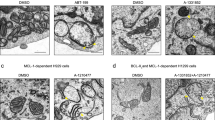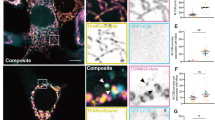Abstract
A lysosomal pathway, characterized by partial rupture of lysosomal membranes and cathepsin B activation, is activated during camptothecin (CPT)-induced apoptosis in U937 and Namalwa cancer cells. These lysosomal events occur simultaneously with mitochondrial permeabilization and caspase activation. In U937 cells, blocking mitochondrial permeability transition pore with cyclosporin A and bongkrekic acid reduces mitochondrial and lysosomal rupture, suggesting that lysosomal rupture may be dependent, in part, on mitochondrial disruption. Overexpressing bcl-xL, an antiapoptotic protein known to preserve mitochondrial functions, also impedes lysosomal and mitochondrial disruption in both cell lines, indicating signaling between the two organelles. In addition, no evidence was obtained of bcl-2-like proteins targeting lysosomes. Caspase activities, including caspase-2L, are required for lysosomal and mitochondrial disruption, and lysosomal cathepsin B slightly participates in apoptosis propagation after CPT, although not essential for apoptosis activation. Our study provides evidence for the participation of a lysosomal pathway during DNA damage-induced cell death. Our data suggest that caspase activation and mitochondrial disruption represent cell-context-specific mechanisms by which DNA damage leads to lysosomal rupture, and that lysosomal cathepsins could slightly participate in apoptosis propagation after CPT.
This is a preview of subscription content, access via your institution
Access options
Subscribe to this journal
Receive 12 print issues and online access
$259.00 per year
only $21.58 per issue
Buy this article
- Purchase on Springer Link
- Instant access to full article PDF
Prices may be subject to local taxes which are calculated during checkout




Similar content being viewed by others
References
Green DR, Kroemer G . The pathophysiology of mitochondrial cell death. Science 2004; 305: 626–629.
Brunk UT, Neuzil J, Eaton JW . Lysosomal involvement in apoptosis. Redox Rep 2001; 6: 91–97.
Turk B, Stoka V, Rozman-Pungercar J, Cirman T, Droga-Mazovec G, Oreic K et al. Apoptotic pathways: involvement of lysosomal proteases. Biol Chem 2002; 383: 1035–1044.
Guicciardi ME, Leist M, Gores GJ . Lysosomes in cell death. Oncogene 2004; 23: 2881–2890.
Brunk UT, Svensson I . Oxidative stress, growth factor starvation and Fas activation may all cause apoptosis through lysosomal leak. Redox Rep 1999; 4: 3–11.
Brunk UT, Dalen H, Roberg K, Hellquist HB . Photo-oxidative disruption of lysosomal membranes causes apoptosis of cultured human fibroblasts. Free Radic Biol Med. 1997; 23: 616–626.
Boya P, Andreau K, Poncet D, Zamzami N, Perfettini JL, Metivier D et al. Lysosomal membrane permeabilization induces cell death in a mitochondrion-dependent fashion. J Exp Med 2003; 197: 1323–1334.
Guicciardi ME, Deussing J, Miyoshi H, Bronk SF, Svingen PA, Peters C et al. Cathepsin B contributes to TNF-alpha-mediated hepatocyte apoptosis by promoting mitochondrial release of cytochrome c. J Clin Invest 2000; 106: 1127–1137.
Kagedal K, Zhao M, Svensson I, Brunk UT . Sphingosine-induced apoptosis is dependent on lysosomal proteases. Biochem J 2001; 359: 335–343.
Heinrich M, Wickel M, Schneider-Brachert W, Sandberg C, Gahr J, Schwandner R et al. Cathepsin D targeted by acid sphingomyelinase-derived ceramide. Embo J 1999; 18: 5252–5263.
Hishita T, Tada-Oikawa T, Tohyama K, Miura Y, Nishihara T, Tohyama Y et al. Caspase-3 activation by lysosomal enzymes in cytochrome c-independent apoptosis in myelodysplastic syndrome-derived cell line P39. Cancer Res 2001; 61: 2878–2884.
Broker LE, Huisman C, Span SW, Rodriguez JA, Kruyt FA, Giaccone G . Cathepsin B mediates caspase-independent cell death induced by microtubule stabilizing agents in non-small cell lung cancer cells. Cancer Res 2004; 64: 27–30.
Foghsgaard L, Wissing D, Mauch D, Lademann U, Bastholm L, Boes M et al. Cathepsin B acts as a dominant execution protease in tumor cell apoptosis induced by tumor necrosis factor. J Cell Biol 2001; 153: 999–1010.
Katunuma N, Matsui A, Le QT, Utsumi K, Salvesen G, Ohashi A . Novel procaspase-3 activating cascade mediated by lysoapoptases and its biological significances in apoptosis. Adv Enzyme Regul 2001; 41: 237–250.
Schmitt E, Cimoli G, Steyaert A, Bertrand R . Bcl-xL modulates apoptosis induced by anticancer drugs and delays DEVDase and DNA fragmentation-promoting activities. Exp Cell Res 1998; 240: 107–121.
Schmitt E, Steyaert A, Cimoli G, Bertrand R . Bax-alpha promotes apoptosis induced by cancer chemotherapy and accelerates the activation of caspase 3-like cysteine proteases in p53 double mutant B lymphoma Namalwa cells. Cell Death Differ 1998; 5: 506–516.
Salvioli S, Ardizzoni A, Franceschi C, Cossarizza A . Jc-1, but not Dioc(6)(3) or rhodamine 123, is a reliable fluorescent probe to assess Delta-Psi changes in intact cells; Implications for studies on mitochondrial functionality during apoptosis. FEBS Lett 1997; 411: 77–82.
Zhao M, Eaton JW, Brunk UT . Protection against oxidant-mediated lysosomal rupture: a new anti-apoptotic activity of Bcl-2? FEBS Lett 2000; 485: 104–108.
Antunes F, Cadenas E, Brunk UT . Apoptosis induced by exposure to a low steady-state concentration of H2O2 is a consequence of lysosomal rupture. Biochem J 2001; 356: 549–555.
Bertrand R, Sarang M, Jenkin J, Kerrigan D, Pommier Y . Differential induction of secondary DNA fragmentation by topoisomerase II inhibitors in human tumor cell lines with amplified c-myc expression. Cancer Res 1991; 51: 6280–6285.
Schmitt E, Paquet C, Beauchemin M, Bertrand R . Bcl-xES, a BH4- and BH2-containing antiapoptotic protein, delays Bax oligomer formation and binds Apaf-1, blocking procaspase 9 activation. Oncogene 2004; 23: 3915–3931.
Paquet C, Schmitt E, Beauchemin M, Bertrand R . Activation of multidomain and BH3-only pro-apoptotic Bcl-2 family members in p53-defective cells. Apoptosis 2004; 9: 815–831.
Vieira HL, Boya P, Cohen I, El Hamel C, Haouzi D, Druillenec S et al. Cell permeable BH3-peptides overcome the cytoprotective effect of Bcl-2 and Bcl-X(L). Oncogene 2002; 21: 1963–1977.
Kokoszka JE, Waymire KG, Levy SE, Sligh JE, Cai J, Jones DP et al. The ADP/ATP translocator is not essential for the mitochondrial permeability transition pore. Nature 2004; 427: 461–465.
He L, Lemasters JJ . Regulated and unregulated mitochondrial permeability transition pores: a ne paradigm of pore structure and function? FEBS Lett 2002; 512: 1–7.
Zhao M, Brunk UT, Eaton JW . Delayed oxidant-induced cell death involves activation of phospholipase A2. FEBS Lett 2001; 509: 399–404.
Marzo I, Susin SA, Petit PX, Ravagnan L, Brenner C, Larochette N et al. Caspases disrupt mitochondrial membrane barrier function. FEBS Lett 1998; 427: 198–202.
Bossywetzel E, Newmeyer DD, Green DR . Mitochondrial cytochrome C release in apoptosis occurs upstream of DEVD-specific caspase activation and independently of mitochondrial transmembrane depolarization. Embo J 1998; 17: 37–49.
Ricci JE, Munoz-Pinedo C, Fitzgerald P, Bailly-Maitre B, Perkins GA, Yadava N et al. Disruption of mitochondrial function during apoptosis is mediated by caspase cleavage of the p75 subunit of complex I of the electron transport chain. Cell 2004; 117: 773–786.
Lassus P, Opitz-Araya X, Lazebnik Y . Requirement for caspase-2 in stress- induced apoptosis before mitochondrial permeabilization. Science 2002; 297: 1352–1354.
Acknowledgements
This work was supported by a grant from the Canadian Institutes of Health Research to RB. RB is a scholar of the Fonds de la recherche en santé du Québec. CP obtained a studentship from the Canadian Institutes of Health Research. We thank Mr Ovid Da Silva (Research Support Office, Research Centre, CHUM) for the editorial work on this manuscript.
Author information
Authors and Affiliations
Corresponding author
Additional information
Supplementary Information
Supplementary Information accompanies the paper on the Leukemia website (http://www.nature.com/leu)
Rights and permissions
About this article
Cite this article
Paquet, C., Sané, AT., Beauchemin, M. et al. Caspase- and mitochondrial dysfunction-dependent mechanisms of lysosomal leakage and cathepsin B activation in DNA damage-induced apoptosis. Leukemia 19, 784–791 (2005). https://doi.org/10.1038/sj.leu.2403717
Received:
Accepted:
Published:
Issue Date:
DOI: https://doi.org/10.1038/sj.leu.2403717
Keywords
This article is cited by
-
Amyloid plaque structure and cell surface interactions of β-amyloid fibrils revealed by electron tomography
Scientific Reports (2017)
-
Cysteine protease cathepsin B mediates radiation-induced bystander effects
Nature (2017)
-
Differential roles of RIPK1 and RIPK3 in TNF-induced necroptosis and chemotherapeutic agent-induced cell death
Cell Death & Disease (2015)
-
Synergistic apoptotic response between valproic acid and fludarabine in chronic lymphocytic leukaemia (CLL) cells involves the lysosomal protease cathepsin B
Blood Cancer Journal (2013)
-
Killing a cancer: what are the alternatives?
Nature Reviews Cancer (2012)



